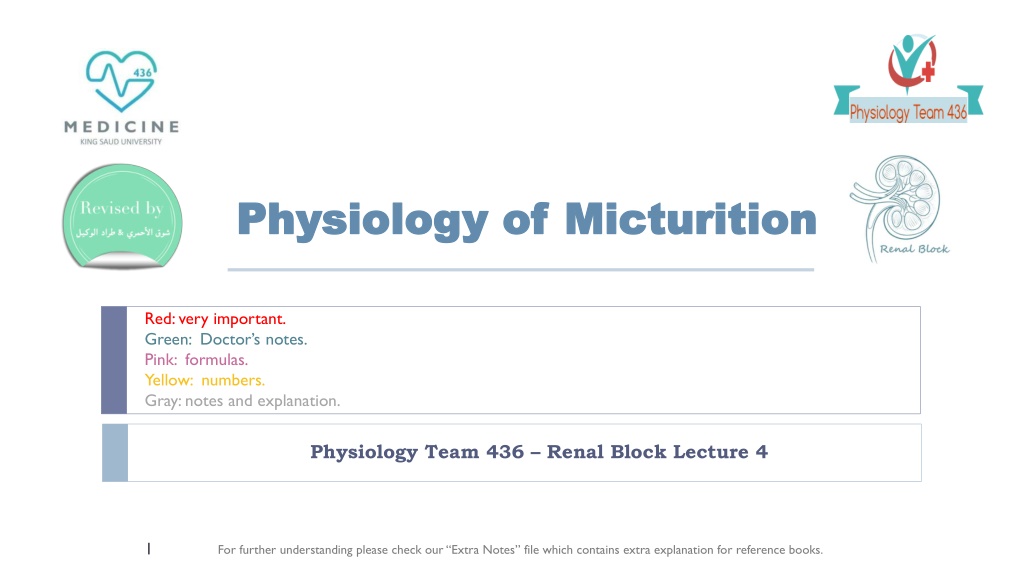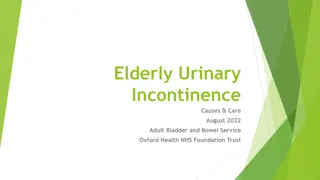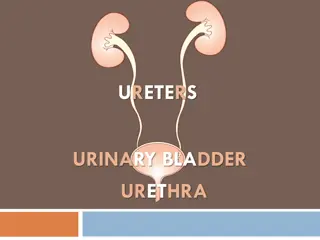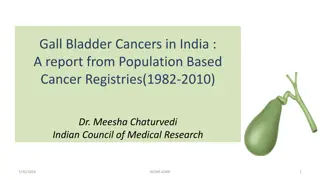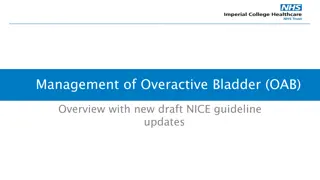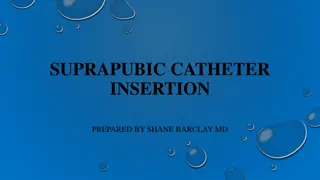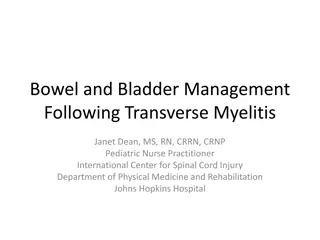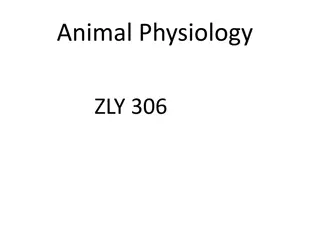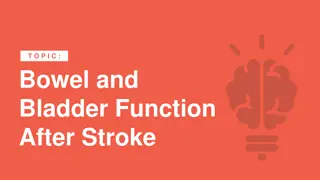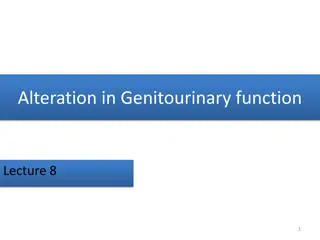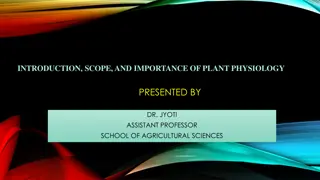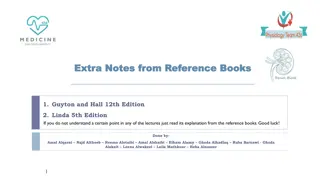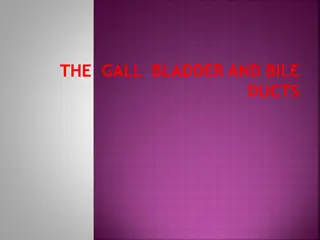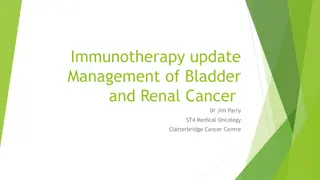Understanding the Physiology of Micturition: Bladder Function and Control Mechanisms
Explore the intricacies of micturition physiology focusing on the functional anatomy of the urinary bladder, mechanism of filling and emptying, cystometrogram, and neurogenic control. Delve into the internal structure of the bladder, sphincters, and innervation in males for a comprehensive understanding of bladder function and control.
Download Presentation

Please find below an Image/Link to download the presentation.
The content on the website is provided AS IS for your information and personal use only. It may not be sold, licensed, or shared on other websites without obtaining consent from the author. Download presentation by click this link. If you encounter any issues during the download, it is possible that the publisher has removed the file from their server.
E N D
Presentation Transcript
Physiology Physiology of Micturition of Micturition Red: very important. Green: Doctor s notes. Pink: formulas. Yellow: numbers. Gray: notes and explanation. Physiology Team 436 Renal Block Lecture 4 1 For further understanding please check our Extra Notes file which contains extra explanation for reference books.
Objectives This work does not contain any notes from the females doctor as she asked us to study the lecture and refer to her for any questions. o Identify and describe the Functional Anatomy of Urinary Bladder. o Describe the mechanism of filling and emptying of the urinary bladder. o Cystometrogram. o Appreciate neurogenic control of the mechanism of micturition and its disorders. 2
ONLY IN MALES SLIDES Urinary bladder The bladder is located in the pelvic cavity when it becomes empty, but it expands superiorly to the abdominal cavity when it becomes full. Site of urinary bladder at early age : The urinary bladder is an abdominal organ at birth, it moves into the lower abdominal wall. Around the 5th or 6th year of age then the bladder gradually descends into the area of the true (minor) pelvis. Urinary bladder is composed of 4 parts : Superior surface Inferolateral surfaces Apex Base 3
Cont. Internal structure of urinary bladder composed of: Mucosa and other parts Is a membrane that lines cavities of bladder. The wall of UB is lined by a transitional epithelium that is continuous with that in the ureters. Mucosa is folded and attached to the wall of the bladder. When the bladder is empty it s numerous folds called rugae and when the urine increase it will flatten out with change in intravesical pressure Change in pressure about 10cm H2O can cause an increase in compliance from 10 ml to 400 ml. Contraction of Detrusor muscle emptying of bladder during micturition. ONLY IN MALES SLIDES We have 2 sphincters: Internal urethral sphincters (IUS) External urethral sphincter (EUS) on either side of urethra, made of smooth muscle. made of skeletal muscle. The urinary bladder, shown in in the figure is a smooth muscle chamber composed of two main parts: (1) the body, which is the major part of the bladder in which urine collects. (2) the neck, which is a funnel-shaped extension of the body, passing inferiorly and anteriorly into the urogenital triangle and connecting with the urethra. The lower part of the bladder neck is also called the posterior urethra because of its relation to the urethra. Internal urethral sphincters Involuntary autonomic supply (sympathetic and parasympathetic ) External urethral sphincter Voluntary (somatic). 4
Innervation of the bladder ONLY IN MALES SLIDES Function Nerve Afferent supply Efferent supply It transmit impulses from the pain receptors to the upper lumbar segment (via the lumbar dorsal n. roots). resulting pain sensation from the urethra & bladder. Detect bladder fullness e.g. severe bladder distension & inflammation. Inhibitory to the bladder wall (detrusor muscle). Motor to the internal urethral sphincter Motor to the seminal vesicle, ejaculatory duct & prostatic musculature. Stimulate mainly the blood vessels and have little to do with bladder contraction. Sensory nerve fibers of the sympathetic nerves also mediate the sensation of fullness and pain. Hypogastric nerve sympathetic Carry input from stretch receptors in the bladder neck. transmit impulses from the tension & pain receptors in the wall of U.B. to the sacral region of spinal cord (via the sacral dorsal n. roots) Resulting in both reflex micturition , sensation of bladder fullness (desire for micturition) and temperature sensation [The tension receptors are stimulated when I.V.P. ] Motor to the bladder wall (detrusor muscle). Inhibitory to the internal urethral sphincter inhibitory= relaxation Contraction of bladder The sensory fibers detect the degree of stretch in the bladder wall Pelvic nerve Parasympathetic It transmit impulses for the sensation of Distension of the urethra and Passage of urine through the urethra. Motor to the external urethral sphincter Fibers that innervate and control the voluntary skeletal muscle of the sphincter Pudendal nerve Somatic Nerve 5
ONLY IN MALES SLIDES Autonomic Innervation of the bladder Sympathetic Parasympathetic Sympathetic supply to the bladder causes Storage of urine. Parasympathetic supply leads to the Passage of urine. Hypogastric nerve Pelvic nerve Nerve Autonomic nerves always originate from lateral horn cells of the spinal cord while the somatic nerves are from the anterior horn cells. Sympathetic supply arises from lateral horn cells of L1-L2 and then it goes to supply the UB causing relaxation of detrusor muscle and contraction of sphincter for example during stressful conditions like exams you feel that you want to urinate but you can t this is due to sympathetic action - remember sympathetic =storage helps in urine storage. Urinary bladder contains stretch receptors which stimulate afferent nerves (sensory) to feel the fullness of UB this afferent nerve is part of pelvic nerve which originate from s2, s3, s4 and the other part (efferent) goes back to urinary bladder causing contraction of detrusor muscles and relaxation of internal sphincter. The most important reflex is parasympathetic reflex and its center located in the sacral plexus lateral horn cell { The pudendal nerve arises from the same origin of parasympathetic but from the anterior horn cells. } LHCs of the L1,L2, L3. LHCs of the S2,S3, S4 Origin Bladder neck Body and neck of the bladder Supply LHC = Lateral horn cell. 6
The Reservoir function of U.B Urine will enter the urinary bladder without producing much increase in I.V.P. till the bladder becomes well-filled. I.V.P. : intravesicular pressure The pressure exerted on the contents of the urinary bladder,being the sum of the intraabdominal pressure from outside the bladder and the detrusor pressure exerted by the bladder wall musculature itself.Also called bladder pressure, vesical pressure . Cystometry Study the relationship between intravesical pressure and volume. Done by inserting catheter and emptying the bladder, then recording the pressure while bladder filled at 50 ml increment of water. The plot of I.V.P. against the volume is called Cystometrogram . A cystometrogram allows us to assess how your bladder and sphincter behave while you store urine and when you pass urine. This test is done for people with urinary incontinence, people who have difficulty with urination, and in people with neurologic diseases that can affect bladder function. This test will measure your bladder capacity and pressure. By doing this we can identify problems such as a small capacity bladder, overactive bladder or high pressure bladder. 7
3 Components (Segments) of The Plot Stage II Stage Ib Stage Ia a sudden, sharp rise in pressure as the micturition reflex is triggered (sense of fullness and urge to void ) This segment is produced by further increment of volume (150 400 ml) Represent initial rise in I.V.P. (when the first increment in volume are produced ) by about 10 cm H2O when the first volume is produced by about 50 ml. It is a long, nearly flat segment produced by further in filling up to nearly 150 ml. The flatness of segment Ib is a manifestation of the Laplace Law which states that the pressure in the spherical viscus equal to twice the wall tension divided the radius { P = 2T / r }. 8
Cystometrogram In the urinary bladder the tension on the wall increases as the volume increases & also the Radiusincreases, so there is little change in pressure until the organ is filled. ( tension = Volume = Radius ) Any increase in volume after this will NOT be accommodated & is reflected by rapid rise of pressure. Superimposed on this curve, periodic acute increase in pressure which lasts very few seconds, & called micturition waves & are caused by micturition reflex. 9
Sensations From The U.B at Different Urine Volumes Micturition reflexes start to appear at this stage. They are progressively intensified in the subsequent stages up to stage 4. Micturition reflexes can be voluntarily suppressed. At about 700 ml break point micturition can not be suppressed. Stage 1 : U.V 150-300 ml 1ST urge to void urine Stage 2 : U.V 300-400 ml sense of fullness of U.B Stage 3 : U.V 400-600 ml sense of discomfort Sometimes when you don t want to urinate and your bladder is extremely filled it will inhibit the pudendal nerve which result in opening of external sphincter . Stage 4 : U.V 600-700 ml sense of pain Break point : U.V 700 ml micturition can t be suppressed * U.B means urinary bladder * U.V means urine volume by ml At the stages from ( 1 to 4 )Micturition reflexes can be voluntarily suppressed as it is progressively intensified. 10
Micturition Micturition Control of Micturition Reflexes Unconditioned (Automatic) In Infants In infants urination occurs through a series of spinal reflexes called the micturition reflexes which are automatic (not under voluntary control) because the nerve tracts are not yet myelinated in infants. Conditioned(Voluntary) In adult In adults the act of micturition occurs also through the micturition reflexes, but however, it can be voluntarily controlled by certain higher (or supra-spinal) centers in the brain, which include the following: Facilitatory : - In pontine area. - Posterior hypothalamus. - Other cortical centers Inhibitory : - In the midbrain It is a complete autonomic spinal reflex to get urine outside the body, that is facilitated or inhibited by centers. higher brain Infants as they born they don t have this control they develop control after 2 years that s why moms always need to change their diapers . The stimulus that initiates these reflexes is rise of the IVP (which stimulates stretch receptors in the bladder wall) 11
The Micturition Reflexes The micturition reflexes can be summarized as follows: Distention of the U.B. (as a result of I.V.P. & not by an in the bladder volume) produces reflex contraction of its wall & relaxation of the internal urethral sphincter & external urethral sphincter. The flow of urine in urethra will produce contraction of the U.B. wall & relaxation of both internal & external urethral sphincters. Higher Centers Control Micturition : ONLY IN MALES SLIDES 1) Cerebral cortex: Motor cortex exerts a voluntary control of micturition either stimulation or inhibition. 2) Hypothalamus: There is facilitatory area in the hypothalamus. 3) Midbrain: Inhibition. 4) Pons: Facilitation 12
Mechanism of Voluntary Control of Micturition Filling of the bladder beyond 300 -400 ml Stretching of sensory stretch receptors These sensory signals stimulate sacral segment which is consciously appreciated by higher centers Condition is Favorable Condition is Unfavorable Higher centers will inhibit the micturition reflex The cortical centers facilitate micturition by discharging signals that leads to: Stimulation (+) of sacral micturition center. Inhibition (-) of pudendal nerves relaxation of external urethral sphincter. Contraction of anterior abdominal muscle & diaphragm to increase intra-abdominal pressure the intra-vesical pressure is increased. This intensifies the micturition reflex. RESULTS IN : Intensifies the micturition reflex Urination Inhibition (-) of sacral micturition center Stimulation (+) of pudendal nerves Contraction of external urethral sphincter RESULTS IN : Inhibit the micturition reflex No urination 13
Mechanism of voluntary control of micturition ONLY IN MALES SLIDES 1) APs generated by stretch receptors 2) reflex arc generates APs that 3) stimulate smooth muscle lining bladder 4) relax internal urethral sphincter (IUS) 5) stretch receptors also send APs to Pons 6) if it is o.k. to urinate APs from Pons excite smooth muscle of bladder and relax IUS relax external urethral sphincter 7) if not o.k. : APs from Pons keep external urethral sphincter contracted As the impulses flow through the afferent part of pelvic nerve other impulses travel to pons in the brain. if you want to urinate, pons will stimulate parasympathetic and inhibit pudendal nerve to open external sphincter. in the other hand, if you don t want to urinate pons will inhibit parasympathetic and stimulate pudendal nerve . 14
Disturbances (Abnormalities) of Micturition Denervation of the afferent supply only such as in : Tabes Dorsalis (tabetic bladder) Denervation of both afferent and efferent nerve supply such as in tumor or injury to cauda equina Loss of the U.B sensations and reflex micturition Abolished (canceled ) reflexes Increase in the intrinsic responses of the smooth muscles Some intrinsic responses of the smooth muscle are retained Hypertonic bladder due to denervation hypersensitivity because : Decreased degradation of Ach by process of reuptake. Decreased cholinesterase in the tissue Increased number of cholinergic receptors The bladder becomes distended, thin walled & hypotonic (atonic bladder) There is retention with overflow. i.e. dribbling of urine when the bladder becomes over filled. This condition is associated with uncontrolled periodic micturition about 25 100 ml at a time 15
ONLY IN MALES SLIDES Disturbances (Abnormalities) of Micturition Tabes dorsalis is a late manifestation of untreated syphilis and is characterized by a triad of clinical symptoms namely unsteadiness, lightning pains and urinary incontinence. It occurs due to a slow and degeneration of nerve cells and fibers in spinal cord. It is one of the forms of tertiary syphilis or neurosyphilis . If the afferent is denervated you won t be able to feel the distention of your bladder, your bladder will continue filling and filling with no orders to contract this will result in dribbling of the excess urine . gait The urinary bladder lost its ability to contract that s why they call it atonic bladder no tone . Afferent nerve is affected in 2 : diseases diabetes mellitus and tabes dorsalis syphilis progressive If both afferent and efferent are damaged the muscle of UB will act as isolated muscles and contract by its self hypertonic Because the afferent and efferent parts of pelvic nerve are located at the end of spinal cord region called cauda equina any injury or tumor to this region will cause bladders muscle to be hypertonic. 16
ONLY IN MALES SLIDES ABNORMALITIES OF MICTURITION ABNORMALITIES OF MICTURITION ATONIC BLADDER Sensory nerve fibers from the bladder to the spinal cord are destroyed Crush injury to the sacral region of the spinal cord and tabes dorsalis AUTOMATIC BLADDER Spinal Cord Damage Above the Sacral Region resulting in Spinal shock Lesion return of excitability of micturition reflex until typical micturition reflexes returns & then, periodic (but unannounced) bladder emptying occurs which may be controlled by scratching or tickling Bladder fills to capacity and overflows a few drops at a time through the urethra. This is called overflow incontinence. Feature If the lesion is in the lumber region above sacral region i.e. :sacral is intact parasympathetic works properly and micturition takes place but it doesn t have higher control the defect is in pons ,cerebral cortex and sympathetic supply the impulses from pons and cerebral cortex won t reach the bladder and their control is stopped this person will urinate involuntarily as if he is a baby . This happen in people with Quadriplegia as result of car accident these patient at the 1st 2 wks will suffer from shock and urinate by dribbling (because parasympathetic in his body used to get impulses from pons and cerebral cortex in his situation no impulses are transmitted to parasympathetic ) after shock has gone the parasympathetic will restore its function and he will urinate normally but without control. . 17
Cont. Disturbances of micturition Spinal cord transaction (Above the sacral region) The spinal cord transaction consist of 3 stages : Stage of spinal shock: Stage of failure of recovery: caused by a sudden separation of the spinal centers from the higher centers that control them, this will cause the spinal centers functionless for 2-6 weeks and the micturition reflex will be abolished retention with overflow i.e. the bladder distends until the I.V.P. exceeds the urethral sphincter resistance & so, urine starts to dribble. Stage of recovery: This stage is caused by toxins and bacterial infection and will lead to abolished micturition reflex then will lead to Retention with overflow . Automatic micturition occurs as soon as the IVP pressure rises to 15-20 cm water, this will cause micturition reflex. Dr.Mannan mentioned this scenario at the beginning of lecture : middle aged patient came to ER due to car accident on x-ray , they found that the patient has broken his lumber vertebrae L3 and L4 which result in paralysis . After 2- 3 wks he suffered from involuntary urination. 18
Thank you! . The Physiology 436 Team: Team Leaders: Qaiss Almuhaideb Lulwah Alshiha Female Members: Aseel Alsulimani Laila Mathkour Male Members: Hassan Alshammari Contact us: Physiology436@gmail.com @Physiology436 Link to Editing File References: Girls and boys slides. 435 Team. Guyton and Hall Textbook of Medical Physiology (13th Edition). Linda (5th Edition). Special thanks to Team435 s Leaders: Meshal Alhazmy & Khawla Alammari and members! 20
